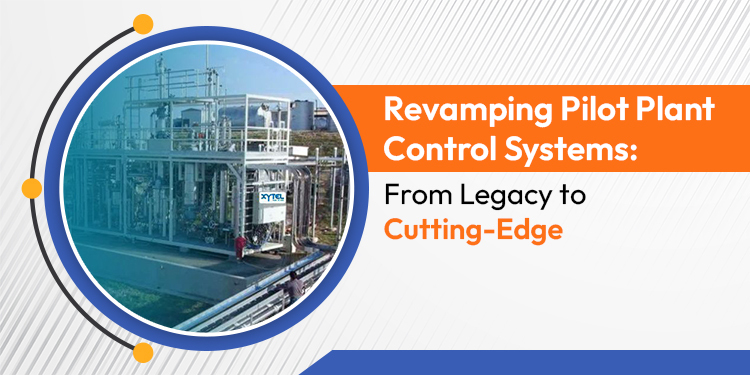Premier Pilot Plant People

Revamping Pilot Plant Control Systems: From Legacy to Cutting-Edge
Revamping Pilot Plant Control Systems: From Legacy to Cutting-Edge
In many industries, pilot plants are the bridge between laboratory innovation and full-scale production. They provide a controlled environment to test processes, validate designs, and refine operations. But as technology evolves, many pilot plants still run on legacy control systems, some decades old, limiting efficiency, scalability, and safety. Revamping these systems isn’t just a matter of upgrading hardware; it’s about transforming how the plant operates, ensuring reliability, precision, and adaptability for future needs.The Legacy System Challenge
Legacy pilot plant control systems, often built on outdated PLCs, early-generation HMIs, or fragmented SCADA setups, pose several issues:- Obsolescence of hardware and software – Components nearing end-of-life with limited or no manufacturer support.
- Limited interoperability – Inability to integrate with newer equipment, sensors, or analytics platforms.
- Manual and reactive maintenance – No self-diagnostics, leading to delayed fault detection and longer downtimes.
- Fragmented control and monitoring – Multiple standalone systems increase operator workload and risk of error.
- Cybersecurity vulnerabilities – Older systems lack modern security frameworks.
Why Modernization Matters
Revamping a pilot plant’s control system is more than replacing parts; it’s an investment in:- Operational safety – Modern systems provide advanced alarm handling, interlocks, and real-time monitoring.
- Data-driven decision-making – Enhanced visibility into process parameters for optimization and predictive maintenance.
- Regulatory compliance – Easier adherence to industry standards and traceability requirements.
- Future scalability – Modular, vendor-agnostic platforms allow expansion and process changes without full redesigns.
Step-by-Step Approach to Revamping Control Systems
1. Define Goals and Scope
Start with a clear understanding of why the upgrade is necessary, whether it’s improving reliability, enabling advanced analytics, enhancing safety, or integrating new process units. Document specific performance targets and compliance needs.2. Conduct a Detailed Assessment
Perform a thorough audit of:- Control hardware – PLCs, DCS controllers, remote I/O modules, and panels.
- Field instruments – Sensors, transmitters, actuators, and final control elements.
- Software – HMI/SCADA applications, historian databases, and custom PLC code.
- Networking – Communication protocols, bandwidth, and topology.
3. Select the Right Modern Platform
Modern control solutions include:- Advanced PLCs like Rockwell ControlLogix or Siemens S7 for high-speed, modular control.
- Hybrid controllers such as Honeywell HC900 for batch, process, and safety functions.
- Full-scale DCS (Emerson DeltaV, ABB System 800xA, Yokogawa CENTUM) for complex, multi-unit operations.
- Vendor-agnostic integration capability.
- Support for modern fieldbus, Ethernet/IP, PROFINET, Modbus TCP, and wireless instrumentation.
- Cybersecurity compliance (ISA/IEC 62443).
4. Incorporate Digital and Edge Technologies
- Digital Twins – Create virtual replicas of processes for simulation, operator training, and predictive analysis.
- IIoT & Edge Computing – Process and analyze data close to the source for real-time insights.
- Cloud Integration – Centralize data storage and enable remote monitoring.
5. Plan for Cybersecurity
As systems become more connected, implement:- Firewalls, VLAN segmentation, and secure remote access.
- Multi-factor authentication for operators and engineers.
- Regular patching and intrusion detection systems.
6. Execute in Phases
To minimize downtime:- Align upgrade phases with planned maintenance shutdowns.
- Consider parallel system installation with switchover during low-production windows.
- Test and validate each stage before moving forward.
7. Documentation and Training
- Develop updated Functional Design Specifications (FDS) and Standard Operating Procedures (SOPs).
- Provide hands-on training for operators, maintenance staff, and engineers.
- Maintain a central knowledge base for troubleshooting and best practices.
Post-Upgrade Benefits
A well-executed modernization delivers:- Reduced unplanned downtime through predictive diagnostics.
- Improved safety compliance with better interlocks and alarm management.
- Greater process flexibility for R&D and scale-up work.
- Enhanced data visibility for continuous improvement initiatives.
- Lower maintenance costs due to the availability of spare parts and vendor support.
Conclusion
Revamping a pilot plant control system from legacy to cutting-edge is a strategic decision that future-proofs operations. It requires careful planning, phased execution, and the right mix of modern technology and human expertise. By embracing advanced control architectures, digital integration, and robust cybersecurity, pilot plants can remain agile, efficient, and ready to take innovation from concept to commercial reality.Get in Touch
You will be amazed as how partnering with us becomes a game changer in your quest for R&D glory.

 Call Us
Call Us